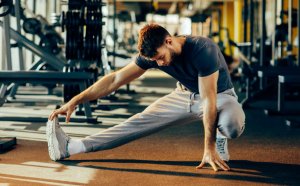Stretching Before Workouts: a Gym Routine Essential

Stretching before workouts is extremely important. However, many exercise devotees skip this essential part because they’re tired or they don’t think it is vital. For this reason, we’re going to take a look at the importance of stretching before workouts.
During this part of the routine, the muscle begins to relax and return to its original length. Stretching allows you to achieve an adequate muscle length to help keep it in good shape.

The effects of stretching before workouts
– Reduces the rigidity of tense muscles. This is highly beneficial because it can affect activities as basic as walking, moving around, or even speaking.
– Improves muscle tone. Also known as residual muscle tension, muscle tone is the partial, passive and continual contraction of a muscle. It helps us maintain our posture and tends to decrease during REM sleep.
– Improves blood circulation. Stretching is vitally important for our bodies because it promotes the transportation of oxygen and nutrients to all our cells while returning carbon dioxide to the lungs for expulsion.
– Reduces the risk of injury. A properly stretched muscle is more elastic. As such, it’s more resistant to future exertion.
– Reduces back pain.
– Improves posture.
– Helps to control stress.
– Improves muscular efficiency.
– Enhances the body’s overall performance.
On the other hand, there’s the matter of flexibility, our ability to move using maximum joint amplitude.
Flexibility is very important because it improves the muscular equilibrium around a given joint. As such, it helps with posture, reduces the chances of injury during athletic activity, increases the supply of blood and nutrients to muscles and cartilage. This also helps reduce any pain experienced after physical activity.

How to stretch
As the main goal of this article is to talk about the importance of stretching before workouts, we should also discuss how best to stretch. The first thing you need to do is warm up, which should take 5 to 10 minutes and remain at a low intensity. This might consist of walking at a quick pace, or a light run at a constant speed.
Once you’ve warmed up, it’s time to stretch in order to prepare your muscles for the effort required by your workout routine.
We suggest stretching each muscle group in a slow and controlled manner. Maintain a light tension and increase progressively without reaching a point where you feel pain. Hold the pose for about 10 to 12 seconds.
The third step is the post-workout stretching session. Account for all the muscle groups you worked out during your routine and stretch them for a bit longer, holding each pose for about 20 seconds.
The goal of post-workout stretching is to help the muscle restore and improve its length. You shouldn’t stretch if you’ve suffered any muscle injury or sprain, or if the joints or muscles evince inflammation or sharp pains following a recent fracture.
Final thoughts
Stretching without having warmed up can result in decreased muscle strength. This can affect your motor performance, and in some cases, lead to injury. Five minutes of improper stretching can reduce your strength for the next two hours.
In conclusion, stretching leads to some terrific overall benefits for our bodies, and helps to prevent injury. It’s essential to be conscious of the role that stretching plays and the musculature involved in order to achieve optimal results.
Stretching before workouts is extremely important. However, many exercise devotees skip this essential part because they’re tired or they don’t think it is vital. For this reason, we’re going to take a look at the importance of stretching before workouts.
During this part of the routine, the muscle begins to relax and return to its original length. Stretching allows you to achieve an adequate muscle length to help keep it in good shape.

The effects of stretching before workouts
– Reduces the rigidity of tense muscles. This is highly beneficial because it can affect activities as basic as walking, moving around, or even speaking.
– Improves muscle tone. Also known as residual muscle tension, muscle tone is the partial, passive and continual contraction of a muscle. It helps us maintain our posture and tends to decrease during REM sleep.
– Improves blood circulation. Stretching is vitally important for our bodies because it promotes the transportation of oxygen and nutrients to all our cells while returning carbon dioxide to the lungs for expulsion.
– Reduces the risk of injury. A properly stretched muscle is more elastic. As such, it’s more resistant to future exertion.
– Reduces back pain.
– Improves posture.
– Helps to control stress.
– Improves muscular efficiency.
– Enhances the body’s overall performance.
On the other hand, there’s the matter of flexibility, our ability to move using maximum joint amplitude.
Flexibility is very important because it improves the muscular equilibrium around a given joint. As such, it helps with posture, reduces the chances of injury during athletic activity, increases the supply of blood and nutrients to muscles and cartilage. This also helps reduce any pain experienced after physical activity.

How to stretch
As the main goal of this article is to talk about the importance of stretching before workouts, we should also discuss how best to stretch. The first thing you need to do is warm up, which should take 5 to 10 minutes and remain at a low intensity. This might consist of walking at a quick pace, or a light run at a constant speed.
Once you’ve warmed up, it’s time to stretch in order to prepare your muscles for the effort required by your workout routine.
We suggest stretching each muscle group in a slow and controlled manner. Maintain a light tension and increase progressively without reaching a point where you feel pain. Hold the pose for about 10 to 12 seconds.
The third step is the post-workout stretching session. Account for all the muscle groups you worked out during your routine and stretch them for a bit longer, holding each pose for about 20 seconds.
The goal of post-workout stretching is to help the muscle restore and improve its length. You shouldn’t stretch if you’ve suffered any muscle injury or sprain, or if the joints or muscles evince inflammation or sharp pains following a recent fracture.
Final thoughts
Stretching without having warmed up can result in decreased muscle strength. This can affect your motor performance, and in some cases, lead to injury. Five minutes of improper stretching can reduce your strength for the next two hours.
In conclusion, stretching leads to some terrific overall benefits for our bodies, and helps to prevent injury. It’s essential to be conscious of the role that stretching plays and the musculature involved in order to achieve optimal results.
All cited sources were thoroughly reviewed by our team to ensure their quality, reliability, currency, and validity. The bibliography of this article was considered reliable and of academic or scientific accuracy.
- Campos, C., & Silvana, A. (2015). Masaje deportivo post competición vs rutina de enfriamiento en miembros inferiores para prevenir contracturas en jugadores de fútbol en el período enero 2015 – mayo 2015. Universidad Técnica de Ambato-Facultad de Ciencias de la Salud-Carrera Terapia Física.
- Maila, N., & Fabricio, J. (2021). Investigación bibliográfica sobre los efectos del estiramiento como estrategia preventiva en deportistas que presentan dolor muscular de aparición tardía. Quito : UCE.
This text is provided for informational purposes only and does not replace consultation with a professional. If in doubt, consult your specialist.








